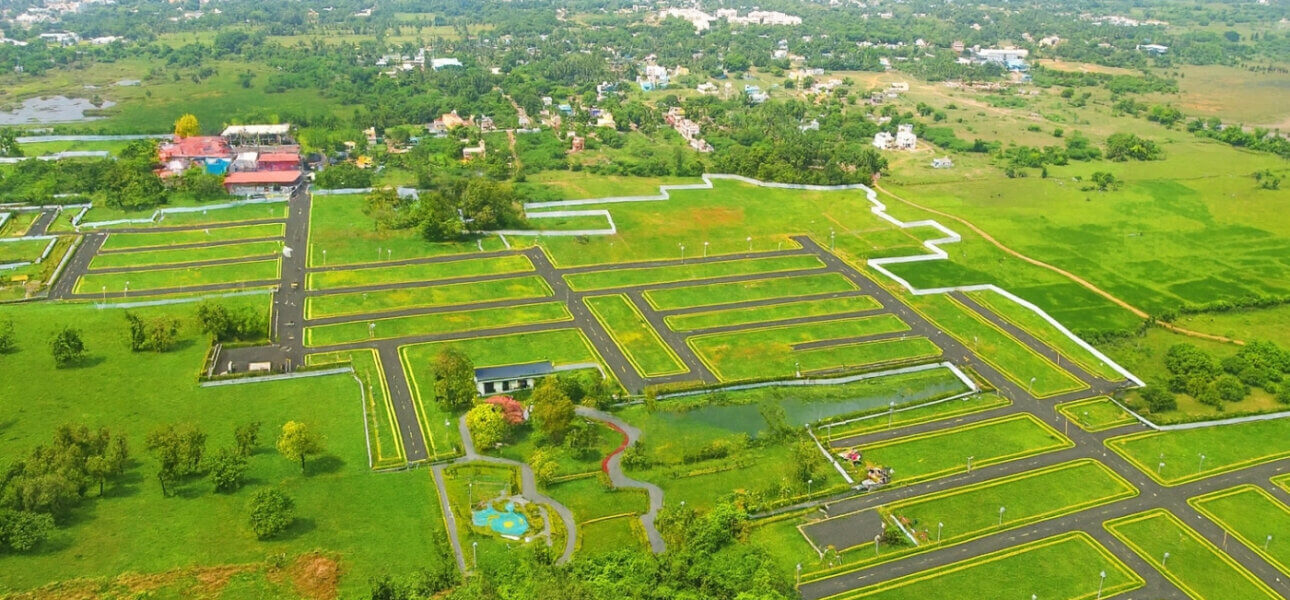A cool home is not only about air conditioners. In Chennai’s climate, the way wind moves across your plot and how you plant your trees can drop indoor temperatures by a few degrees naturally. Smart orientation and the right green cover turn everyday sea breezes into your personal cooling system and save electricity month after month.

Understand Chennai’s Wind Pattern in Simple Terms
Chennai is blessed with coastal winds. For most of the year, gentle day breezes flow from the east and south east, while evenings often turn a bit south to south west. In monsoon months, winds can swing but the general idea holds. In Padappai and the Oragadam belt, you are slightly inland, so channelising wind through streets and courtyards becomes important.
Plot Orientation: Start with Openings on Windward Sides
If you are still planning your home at Velammal Garden, set the main living spaces and operable windows toward the prevailing breeze.
- Keep larger windows or French doors on the east and south east to catch morning wind and soft light.
- Provide cross ventilation by placing smaller high windows or ventilators on the west and north west. This allows air to enter from the breeze side and exit smoothly.
- Use window types that open wide such as casement or tilt and turn. Sliding windows open only partially and reduce effective airflow.
The Three Layer Cooling Strategy with Trees
Think of your landscape in layers. Each layer plays a role in cooling and shading.
Layer 1: Tall Shade Trees as the First Filter
Plant tall, deep rooted natives on the south and west boundaries. They block harsh afternoon sun and push cooler filtered air toward the house.
- Good choices for our soil and climate include neem, poonga, pungam, peepal near boundary edges only, rain tree, and native ficus species.
- Maintain a clear trunk height for wind passage under the canopy. Prune lower branches thoughtfully to avoid blocking ventilation grills.
- Avoid very dense belts directly in front of primary east openings. You want dappled shade, not a wind wall.
Layer 2: Medium Canopy Trees for Courtyard Comfort
Inside the plot, use mid height species to temper the air before it enters rooms.
- Try guava, jamun, sapota, and small mango varieties. They cool courtyards and provide seasonal fruit.
- Place them near corners of verandahs and along setbacks to guide airflow toward windows.
- Keep at least one open air corridor from the breeze side to the living area. Do not overcrowd the middle of the site.
Layer 3: Low Hedges and Groundcovers for Microcooling
Close to the house, green the earth to reduce reflected heat and dust.
- Low hedges like ixora, jasmine, and hibiscus create soft edges without blocking wind.
- Groundcovers and lawns lower ground temperature. Use hardy zoysia or native grasses that need less water.
- Leave two to three feet of breathing space below sills to keep air pathways open.
Tree Layout Templates You Can Copy
Every site is unique, but these simple templates work well for Velammal Garden plot sizes.
For a 30 by 50 plot
- Two tall shade trees on the south west and west boundary corners.
- One medium canopy fruit tree in the north east courtyard.
- Low hedge along the front compound wall with a gate aligned toward the breeze.
- Clerestory vents above living room windows to accelerate cross ventilation.
For a 40 by 60 plot
- A staggered row of three tall shade trees along the west boundary spaced six to seven metres apart.
- Two medium trees flanking the verandah to funnel wind into the living and dining.
- A central lawn court or permeable stone court for night time radiative cooling.
- Kitchen and utility get smaller operable windows on the leeward side for outflow.
Breeze Pathways: Do Not Create Wind Obstacles
Even the best planting fails if hard structures block movement.
- Keep compound wall parapets at moderate height where the breeze enters. Use perforated jalis or grill sections strategically.
- Car porches with solid side walls become wind stoppers. Prefer light roof with open sides.
- Storage sheds should be pushed to the north west corner instead of the breeze entry side.
Shading Devices That Work with Wind
Combine plants with passive elements so air flows while sun stays out.
- Deep verandahs and pergolas on the east and south sides create cool transition zones.
- Vertical fins and adjustable louvers let you tune shade without sealing the opening.
- Light coloured exterior finishes reflect heat and let moving air do more cooling.
Water, Permeable Paths, and Heat Island Control
- Add a small water feature or rain garden downwind of the verandah. Evaporation gently cools incoming air. Keep it clean to avoid mosquitoes.
- Use permeable pavers and gravel bands around the house. Hot concrete raises ambient temperature and weakens wind’s cooling impact.
- Plant climbers on south and west facing compound walls to cut radiant heat.
Maintenance for Year Round Cooling
- Seasonal pruning to maintain airflow corridors. Think of it as grooming the wind paths.
- Mulch tree bases to retain soil moisture and support healthy canopies.
- Clean insect screens and window hardware so you actually keep windows open when the breeze is good.
- Check roof insulation and attic vents. When hot air escapes above, cross ventilation works better below.
Why This Matters for ROI
Sustainable planning lowers your monthly energy bills and improves resale value. A home that breathes well and stays cooler naturally appeals to tenants and future buyers in the Oragadam job market. At a community like Velammal Garden, a thoughtful tree layout also elevates the streetscape and neighbourhood wellness. Explore available villa plots and master layout details at velammalgarden.com and book a site visit through velammalgarden.com to experience the natural breeze on ground.
Quick Placement Do’s and Don’ts
- Do align main living room openings toward the breeze side.
- Do keep taller shade to the west and south boundaries.
- Do maintain one clear green corridor from boundary to verandah.
- Do use native species that handle Chennai heat and water conditions.
- Don’t overplant the centre of the plot.
- Don’t build solid side walls around car porches on the breeze side.
- Don’t use dense hedges right in front of windows.
Sample Native Planting Palette for Padappai
- Tall canopy: neem, rain tree, pongamia, badam.
- Medium fruiting: guava, jamun, sapota, drumstick.
- Shrubs and hedges: hibiscus, jasmine, kaner, ixora.
- Climbers: bougainvillea, garlic vine, rangoon creeper.
- Groundcovers: dwarf ixora, wedelia, native grasses.
Simple Cost Smart Tips
- Plant young saplings during early monsoon for stronger root takeoff and lower watering.
- Use harvested rainwater and greywater for landscape irrigation.
- Mix compost with native soil for slow release nutrition.
- Choose fewer species in repetition for a clean look and easier care.
Call to Action for Plot Owners
Already own a plot in Velammal Garden. Mark the breeze entry on your boundary and sketch your three layer planting today. If you are still evaluating plots, walk the site in the morning and late afternoon to feel the natural airflow before you finalise orientation.
FAQs
How does wind direction really help cooling in homes
Wind enhances cross ventilation, which replaces hot indoor air with cooler outdoor air and removes humidity. When openings are aligned with the breeze, indoor temperature drops and comfort improves even without air conditioning.
Which side should I plant tall shade trees in Chennai
Place tall shade trees along the west and south boundaries to cut harsh afternoon sun. Keep the east side lighter with medium canopy and climbers so that morning breeze can enter freely.
What tree spacing is ideal for small plots in Padappai
For tall species, maintain six to seven metres spacing on boundaries. For medium fruit trees, three to four metres is comfortable. This spacing avoids root conflicts and keeps wind paths open.
Will dense hedges in front of windows keep my home cooler
Dense hedges block airflow and trap humidity. Use low hedges below sill height and keep at least two to three feet of clearance. Let air move under canopies and through verandahs.
How can Velammal Garden’s layout support natural cooling
Wide internal roads, green verges, and scope for boundary planting allow residents to channel breeze toward homes. By combining plot orientation, verandahs, and layered native trees, homeowners can achieve a pleasant microclimate with lower energy use. For site visits and plot options, check velammalgarden.com.
Make nature your first air conditioner. With a smart wind direction plan and thoughtful tree layout, your sustainable home in Padappai can stay cooler, fresher, and more liveable all year.


